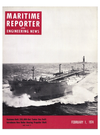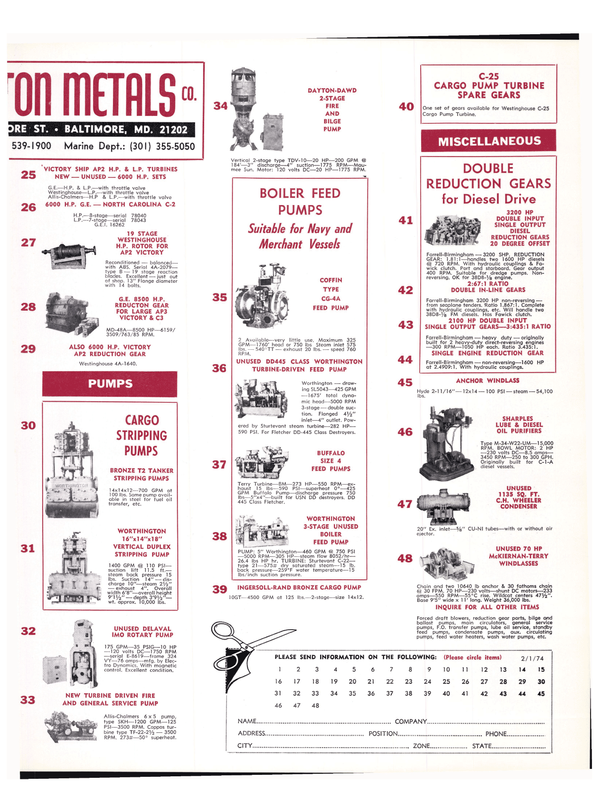
Experimental LNG Carrier Will Evaluate Two Tank Systems Under Operating Conditions
An experimental LNG carrier was recently launched at the Taguma Shipyard of Naikai Shipbuilding & Engineering Co., Ltd., one of Hitachi Zosen's affiliated companies. This 1,000 cubic meter LNG ship is one of the steps being taken by Hitachi Zosen to solve shipbuilding and design problems prior to entering into the construction of large LNG carriers. This Japanese firm established in 1970 an LNG Carrier Development Project to conduct 'research based on its previous experience in building LPG carriers.
The purposes given by Hitachi Zosen for this project are: 1. To confirm the greater safety of the Hitachi Zosen system (a prismatic, independent tank) and the Chicago Bridge & Iron system (a spherical, independent tank).
2. To solve problems regarding construction methods.
3. To obtain an accurate measure of building efficiency per unit of time.
4. To make sure by the trialrun construction that the construction of actual LNG carriers can be performed smoothly.
The testing program will include : 1. Detailed tests will be conducted on land on the strength of the tank and the tank-supporting structure in a static state before installation, since there are many restrictions on the methods of measuring and testing on board ship.
2. After the tanks have been installed in the ship and while at the dock, relations (between the hull and the tank will be checked by rolling and pitching the carrier on a calm sea surface.
3. Based on the above test data, tests will 'be performed at sea to check the relations between the hull and the tanks and the surface effects of liquids in the tanks.
4. After cooling the tanks with liquid nitrogen until the working temperature is reached, the insulation, cooling conditions and the deformation of the tanks and the hull will be checked.
5. After the ship has sailed as an ethylene carrier, long-term tests will be conducted to determine the actual sailing conditions under which the LNG carrier must operate.
This will enable the compilation of the necessary statistical data.
This experimental ship has a length between perpendiculars of 196 feet 10 inches, a beam of 42 feet inches, a depth of 21 feet 4 inches and a 'draft of 13 feet Sx/2 inches. It is propelled by a single diesel engine developing 1,300 bhp.
As can be noted from the accompanying sketches of the ship, two tank systems are being tested. The prismatic tank with insulation were constructed by the Innoshima Shipyard of Hitachi Zosen. The CBI-type spherical tank and related parts were built at the Kanagawa Shipyard of Hitachi Zosen.
The Hitachi Zosen system was developed through the Hitachi Zosen's unique technology in the fields of LNG carriers based on its previous experience and joint research and development by Hitachi Zosen and Exxon International Company. The main features of this system are: Self-supporting, prismatic, independent tank of nine percent nickel steel; welding of nine percent nickel steel 'by using a new filler metal, "HZ-OL," developed for automatic welding by Hitachi Zosen; a double thermalinsulation system, and specially treated plywood with a simple and rational structure for the secondary barrier.
The spherical, independent tank was made of aluminum and is based on the system developed by Chicago Bridge & Iron Company. The main features of this system are: Self-supporting, spherical, independent tanks of aluminum that can be manufactured outside of the hull.
Read Experimental LNG Carrier Will Evaluate Two Tank Systems Under Operating Conditions in Pdf, Flash or Html5 edition of February 1974 Maritime Reporter
Other stories from February 1974 issue
Content
- Shipyard Marketing Conference Planned page: 4
- Cordon International To Supply Equipment For Three LNG Ships page: 6
- Sixth VLCC Delivered By Kockums To Salen Features Roller Bearing Design For Shaft page: 7
- Admiral Payne To Succeed Admiral Brockett At Webb page: 7
- NASSCO Launches Largest Vessel Ever Built On West Coast page: 7
- Walter Thorsen, Inc. Named Exclusive Rep For Eleusis Shipyards page: 8
- Ogden Marine, Inc. Buys Two Tankers page: 10
- Oceans International Announces Merger And Expansion Plans page: 10
- Aluminum Tanks And LNG Ship Steel Hulls To Be Joined By Using Du Pont Detacouple Explosion Bonded Welding Transition Joints page: 11
- McAllister Orders Three 4,290-Hp Tugs page: 11
- Delta SS Awards Contract To Equitable For 50 LASH Barges page: 12
- Bethlehem Begins Construction On 265,000-Dwt Tanker —Largest Vessel Built In The United States page: 12
- Arthur Levy Boat Service Announces New Appointments For Thomas And LeBlanc page: 12
- Greek Committee Established By Det norske Veritas page: 13
- Esso Norway Test Of Hull Structure Proves Design And Good Workmanship page: 14
- Todd President Sees U.S. Shipbuilders Improving Competitive Position page: 14
- Society Of Marine Port Engineers N.Y. Discuss Care Of Turbine And Hydraulic Oil Systems page: 14
- Harwich Tonnage, Inc. Formed In California page: 15
- K.W. Waldorf Named To New Zapata Post page: 15
- Bigger, Bigger . . . Bigger page: 18
- USMMA At Kings Point To Admit Women page: 19
- Storm Awards Contract To Bethlehem Beaumont Shipyard For Offshore Drilling Rig page: 20
- NASSCO Expanding Facilities To Build 150,000-Ton Tankers page: 20
- NASSCO Delivers S/S Coronado— First Of Three For Margate Shipping page: 21
- SNAME N.Y. Metropolitan Section Hears Technical Paper On 'New Approach To The Ship Hull Characteristics Problem' page: 21
- ASNE Annual Meeting Set For May 2-3 In Washington, D.C. page: 21
- Experimental LNG Carrier Will Evaluate Two Tank Systems Under Operating Conditions page: 24
- International Ship Suppliers To Meet In Washington, D.C. September 22-26 page: 24
- Thomas B. Crowley Elected President At Western Shipbuilding Ass'n Annual Meeting page: 24
- Whitehouse To Head ABStech Regional Office In Houston page: 25
- Colt Industries Names Nidenberg page: 25
- FMD Appoints Sanchez To Direct Field Operations page: 25
- Alco Engines Names Comeng Holdings Ltd. Australian Licensee page: 25
- Magnavox Announces New Integrated Navigation System page: 28
- Friede & Goldman Inc. Design Zapata Rigs Building At Avondale page: 28
- Sea Trials And Launching Ceremonies Held For AMOCO Tankers At Astilleros Espanoles page: 28
- Halter Delivers New York Pilot Boat page: 29
- Ametco Shipping Elects J.E. Hundt President page: 29
- World Dredging Ass'n New Midwest Chapter To Meet February 28 page: 29
- Wiley And Clyde Iron Now Division Of AMCA Int'l —AMCA Sales $100 Million page: 30
- Kaiser To Build LNG Tanks For Oceangoing Ships On Pinto Island In Mobile Bay page: 30
- Eleusis Shipyards Launches Largest Vessel Built In Greece page: 31
- Paclines To Carry Cargo California To Hawaii Using Tug And Superbarge page: 31
- L. Arthur Strenkert Named Sales Manager Smit Nymegen Corp. page: 31
- Magnavox Announces Offshore Drill Rig Positioning System page: 31
- Paul J. Evanson Appointed Controller Moore And McCormack page: 32
- Paper On Water jet Propulsion Discussed During SNAME Philadelphia Section Meeting page: 32
- Mainland China Places Order Worth $2 Million For Rucker Petroleum Drilling Equipment page: 33
- Pittsburgh-Des Moines Orders Large Quantity Of Aluminum For LNG Ship And Land Use page: 33
- Worthington Service Corp. Names Budrick And lennings page: 33
- Zapata Corporation Reports Record Results page: 33
- Drew Chemical Names Rogers Managing Director New So. Africa Subsidiary page: 33
- Luckenbach To Build New Tampa Terminal page: 33
- SNAME Players Perform At Pacific Northwest Section's 27th Annual Fall Meeting page: 33
- Japanese Firm Buys Lawson Products Corp. —John Gaydos Named page: 34
- David O'Neil To Head New Firm Of Marine Propulsion Consultants page: 34
- Liberian Services —Consulting Firm Elects Wiswall Pres. page: 35
- Diamond M Orders Two Jackup Rigs And A Semisubmersible page: 35
- New Marine Systems Brochure From Waukesha Motor page: 36
- Management Changes At Dearborn-Storm page: 36
- Tanker Management Firm Promotes Nichols page: 36
- DOD Management Of Energy Resources Highlights Naval Engineers Meeting page: 37
- Raytheon Company Submarine Signal Div. Appoints R.G. Popovici page: 38
- Berwind Lines Names Bericochea Exec. VP page: 38
- Selective Calling System Saves Time For Oceangoing Tankers And River Vessels page: 40
- Storehouse Of Information Readily Available From ABS Using Computerized Retrieval page: 42


